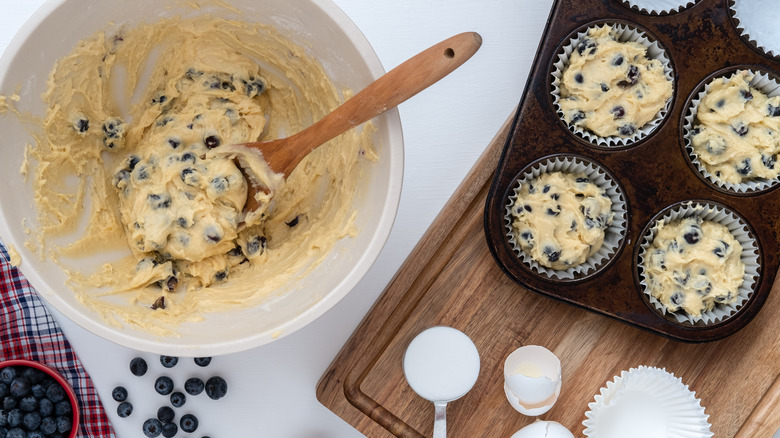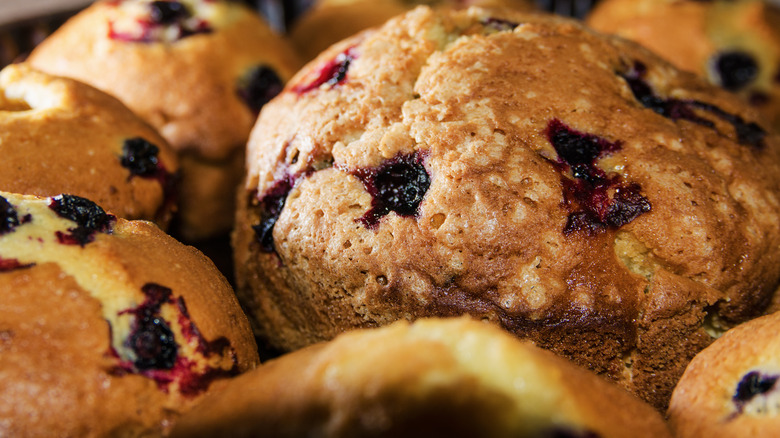Alton Brown's Trick For Delicious Top-Heavy Muffins
Arguably, everyone's favorite part of a muffin is the top, the portion that looks the most appetizing with its browned, caramelized exterior and fruit bursting through. While the lower portion may be soft, it honestly has the flavor and texture of any given cake while the top is more like a cross between a freshly baked cookie and a sliver of cake. If baker extraordinaire/mad scientist Alton Brown's latest blueberry muffin recipe tells his fans anything, it's that he, too, is a fan of the muffin top. And, no, he doesn't use a muffin top pan to get them.
In his opinion, if you want bigger muffin tops, use a regular sized muffin pan but fill it with more batter. Most muffin recipes will advise against this, as the batter rises in the oven. If the tins are overfilled, they overflow onto the top of the pan, sticking to them. This is precisely what Brown wants you to do. You'll ultimately end up with the normal sized, boring lower portions and huge muffin tops. As far as the batter sticking to the pan, yes, this is the reality of such a method, but as long as you take precautions, you won't have to worry about the tops adhering to the pan at all.
Brown wants you to batter up
Brown's recipe for "Over The Top Blueberry Muffins" begins with coating a standard-sized muffin pan with nonstick baking spray. Don't merely focus on the muffin portions, spray the flat top of the pan as well. This way, when the batter overflows, it will lay on a sprayed surface and won't stick. Brown whisks together the dry ingredients including flour, baking powder, baking soda, and salt and then separately whisks the wet ingredients together. Unlike a previous blueberry muffin recipe of his, Brown's wet ingredients include two whole eggs and two egg yolks. He also includes Greek yogurt and orange zest.
Standard muffin tins are designed to hold about a half cup's worth of batter, allowing space for the tops to rise without overflowing. Brown calls the bluff in his recipe as he instructs bakers to pour a full cup of batter into each muffin portion. Don't be alarmed if the cups are filled to the brim, they're supposed to be. Once baked, you'll see where most of the batter goes: up and out of the tin, baked into beautiful, browned domes.
Other pro tips for drool-worthy muffins
Overfilling the cups isn't the only trick Brown has up his baking sleeve in this recipe. His other key to perfectly baked muffins is to remove the muffins from the tin immediately after removing it from the oven and turning them upside down to cool. He notes that this will prevent the bottoms of the muffins from turning wet and soggy. Perhaps now those bottom muffin portions won't be so dull after all.
Brown does mention that when you measure the cup of batter, it should be a scant cup, so maybe barely less than a cup measurement and certainly no more than a cup. After all, you want the batter to rise and spread, but not so much that the batter will actually start dripping off the edges of the pan. You can use Brown's method in "overfilling" your muffin pan for any type of muffin recipe like Cappuccino Cinnamon Pecan Muffins or Sugared Mango Muffins. Just be aware that this could yield less muffins than what the recipe states since you'll be pouring more batter into each muffin portion.



